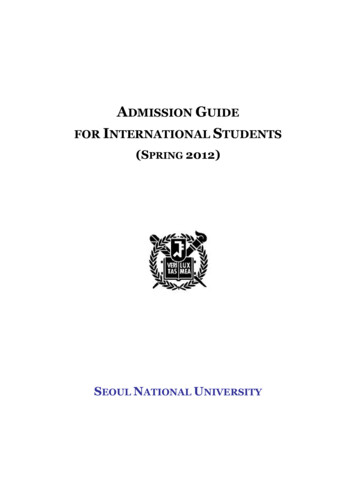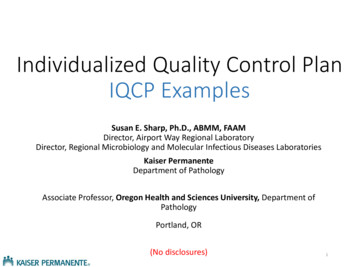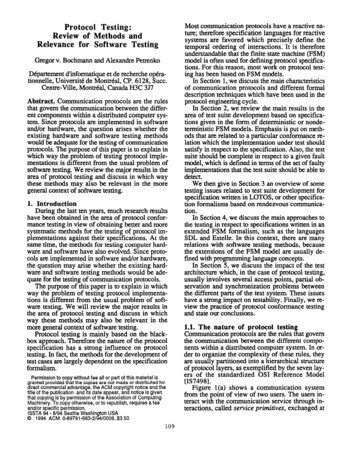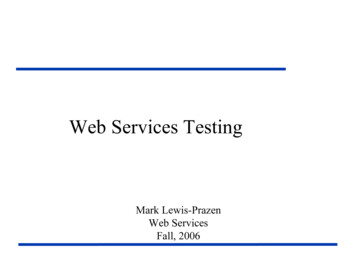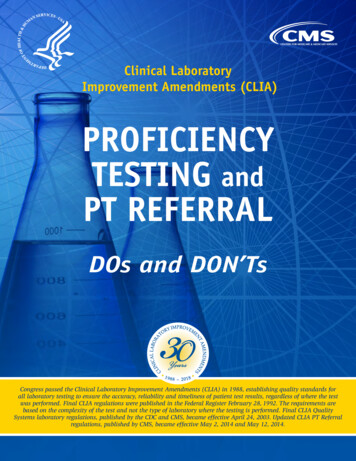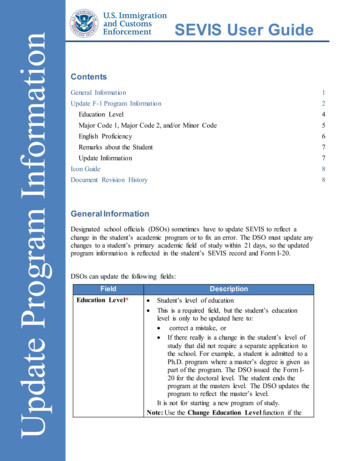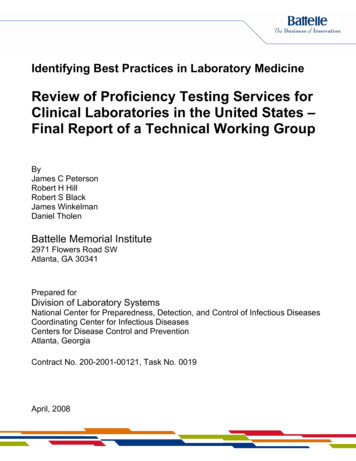
Transcription
Identifying Best Practices in Laboratory MedicineReview of Proficiency Testing Services forClinical Laboratories in the United States –Final Report of a Technical Working GroupByJames C PetersonRobert H HillRobert S BlackJames WinkelmanDaniel TholenBattelle Memorial Institute2971 Flowers Road SWAtlanta, GA 30341Prepared forDivision of Laboratory SystemsNational Center for Preparedness, Detection, and Control of Infectious DiseasesCoordinating Center for Infectious DiseasesCenters for Disease Control and PreventionAtlanta, GeorgiaContract No. 200-2001-00121, Task No. 0019April, 2008
April 2008Dear Colleague:I am pleased to announce a new report based on work sponsored by the Division ofLaboratory Systems Laboratory Medicine Best Practices initiative, Review of ProficiencyTesting Services for Clinical Laboratories in the United States – Final Report of aTechnical Working Group, prepared by Battelle Memorial Institute.The Laboratory Medicine Best Practices initiative aims to: Improve patient safety and health care outcomes by improving the use oflaboratory testing in screening, diagnosis, monitoring, and management ofdisease Reduce redundancy and waste in laboratory services Provide tools that laboratories can use to improve quality of service to cliniciansand patientsThis report assesses proficiency testing (PT) in relation to the regulatory, educational,and quality improvement objectives of the Clinical Laboratory ImprovementAmendments of 1988.The findings and conclusions in this report are those of the author(s) and do notnecessarily represent the official position of the Centers for Disease Control andPrevention.Work on the Laboratory Medicine Best Practices initiative continues in 2008. For moreinformation about the initiative, please visit our web site athttp://wwwn.cdc.gov/dls/bestpractices/. I hope you find the report of interest.Sincerely yours,D. Joe Boone, Ph.D.Acting DirectorDivision of Laboratory Systems (DLS)National Center for Preparedness, Detection,and Control of Infectious DiseasesCenters for Disease Control and Preventioni
The following Battelle staff members were primarily responsible for the content of this report:James C. Peterson, PhDResearch Leader, Analytical Chemistry ServicesBattelle Eastern Science and Technology CenterAberdeen, MarylandRobert H. Hill, Jr., PhDPublic Health Program ManagerAtlanta Analytical Chemistry GroupAtlanta, GeorgiaRobert S. Black, MPHSenior Health Research ScientistCenters for Public Health Research and EvaluationAtlanta, Georgiawith substantial contributions from subcontractorsJames Winkelman, MD, FACPProfessor, Harvard Medical School (Emeritus)Chestnut Hill, MassachusettsandDaniel Tholen, MSDan Tholen Statistical ConsultingTraverse City, Michiganii
CONTENTSCOVER LETTER. IEXECUTIVE SUMMARY .VObjectivesvProcessvBackgroundvAssessment tasksviRecommendationsviiCHAPTER 1. INTRODUCTION . 1Objectives1Process1Report Organization2CHAPTER 2. BACKGROUND. 4Brief history of PT implementation in the United States4PT is one of the essential elements of a quality management system4Roles and responsibilities of regulatory bodies, PT providers, and PT participants5The PT process as currently practiced in the United States8Limitations of PT8Attributes of a good PT program10CHAPTER 3. PT WORKING GROUP TASK REPORT . 13Task 1: To evaluate PT programs used by U.S. laboratories to determine to what extent theseprograms meet quality improvement, educational, and regulatory goals.13What evidence is available that PT is effective?How can we obtain new evidence of the effectiveness of PT?What criteria can be used to evaluate a PT provider’s performance?Task 1 Recommendations13161617Task 2: To evaluate the need to improve the use of PT programs .19What are the gaps and needs in current PT program content?19What improvements are needed in the design of PT samples, the integrity of samplesbeing distributed, and PT distribution?21How can the evaluation (grading, scoring) of PT results be improved?23Task 2 Recommendations28Task 3: To evaluate ways to enhance the educational value of PT programs.29What are the best ways to enhance educational value of PT and to evaluateeffectiveness of any changes?Task 3 Recommendations3031iii
Task 4: To determine how well the PT programs are providing challenges to keep up withadvances in laboratory testing technology .33For what areas of clinical laboratory testing is PT currently not available?33What alternatives exist to assure that PT is available as rapidly as possible in newtesting areas or for new technologies?33Task 4 Recommendations38Task 5: To determine whether accreditation of PT programs to an international standard wouldincrease the quality or uniformity of programs .39What are the barriers and facilitators for adopting an international standard?How can the other stakeholders be assured that the PT providers are operatingprograms that meet their needs?Task 5 Recommendations434444CHAPTER 4. RECOMMENDATIONS. 45Data Collection and Analysis45Process Improvement46Process Evaluation49REFERENCES. 50Prepared for Division of Laboratory Systems, CCID/CDCiv
EXECUTIVE SUMMARYIn 2006, the Division of Laboratory Systems (DLS) at the Centers for Disease Control andPrevention (CDC) assembled a thirteen-member Working Group to assess the effectiveness ofclinical laboratory proficiency testing (PT) for regulatory, educational, and quality improvementpurposes. Members were chosen for their expertise in PT and laboratory medicine and comprisedPT users, PT providers, and representatives of accrediting organizations.ObjectivesDLS/CDC representatives charged the Proficiency Testing Working Group (PTWG) toaccomplish four primary objectives:1. Report on the status of current clinical PT programs in the US, assessing the success ofPT in improving the quality of clinical testing and identifying areas in whichimprovements are needed.2. Make recommendations for improving the effectiveness of PT in meeting regulatory,educational, and quality improvement objectives.3. Solicit and consider input from stakeholders including PT providers, PT users in severaltypes of clinical laboratories, and accrediting organizations; assess the feasibility ofrecommendations.4. Identify needed improvements to PT that could be addressed during the next five years.ProcessThe PTWG met in January and May 2007 to address a series of questions developed by DLSstaff and Robert Rej, PhD, the PTWG Chair. Battelle solicited input from stakeholders in thelaboratory medicine community in a two-step process. Before the initial Working Groupmeeting, Battelle invited 79 stakeholder organizations to submit comments and relevant data.After the PTWG’s second meeting, Battelle sent a summary of salient points to be considered inthe final report to all stakeholders, along with an invitation to provide additional comments,suggestions, or relevant data. A total of 20 organizations submitted comments. Staff fromBattelle and DLS/CDC and the PTWG Chair reviewed all comments and integrated them into thereport narrative.BackgroundWith the passage of the 1988 Clinical Laboratory Improvement Amendments (CLIA ’88) and itsimplementing regulations, laboratories performing non-waived testing for selected analytes andtests were required to participate in PT. CLIA established a framework for certification ofclinical laboratories operating in the United States and for use of PT in assessing laboratoryperformance. The 1992 regulations identified analytes in 16 clinical laboratory specialties andsubspecialties and specific PT criteria for each analyte. For most analytes, PT programs mustinclude at least three events annually, each of which must include five samples. For mostPrepared for Division of Laboratory Systems, CCID/CDCv
specialties, satisfactory performance requires that 80% (4/5) of a participating laboratory’s testresults fall within a specified range of analytical precision. PT providers issue PT samples toeach subscriber laboratory, receive results of PT analyses from each laboratory, report PT resultsback to laboratories, and report laboratory performance evaluated against specific scoring criteriafor CLIA-required PT tests for each laboratory to the Centers for Medicare and MedicaidServices (CMS), which is primarily responsible for administering CLIA. The CMS approvalprocess requires PT providers to demonstrate annually how each meets the requirements of theCLIA regulations.Many tests for analytes that were not included in CLIA regulations are now in common orroutine clinical use. For example, tests for cardiac markers such as troponins and many types ofmolecular genetic testing that are now in general use did not exist in 1992. Although PT is notrequired for “non-regulated analytes,” laboratories are required to verify the accuracy andreliability of test results for these analytes at least twice a year.Assessment tasksThe PTWG’s work was organized into five interrelated tasks, which are listed here. The WorkingGroup discussed each task in light of the current state of the field and attempted to identify gaps;the group discussed potential approaches to fill gaps or improve processes and programs.Task 1. To assess how well PT programs used by U.S. laboratories meet qualityimprovement, educational, and regulatory goalsThe PTWG considered existing evidence that PT is effective, possible approaches to gatheradditional data, and criteria for assessing the performance of PT providers.Task 2: To evaluate the need to improve the use of PT programsThe Working Group considered gaps in current PT program content; potential improvements inthe design, integrity, and distribution of PT samples; and possible approaches to improving theevaluation (grading or scoring) of PT results.Task 3. To evaluate ways to enhance the educational value of PT programsPT has an important educational role, both in remediation after a PT failure and in raisingawareness of the value of monitoring trends in PT results for warning signs of impendingfailures. The Working Group discussed several ways in which PT providers can reinforce theeducational element of PT.Task 4. To determine how well PT programs are providing challenges to keep up withadvances in laboratory testing technologyPrograms offered by domestic PT providers cover analytes that comprise the bulk of laboratorytesting volume. Gaps in PT coverage exist for newly developed tests, esoteric tests, tests inwhich analyte stability is problematic, and tests of analytes in matrices such as hair, saliva, andsweat. Reference and specialized laboratories that conduct these less common tests are mostlikely to encounter problems because of these gaps. PT for molecular diagnostic testing presentsPrepared for Division of Laboratory Systems, CCID/CDCvi
special challenges because of the large number of clinically relevant gene targets. Methods-basedPT may be the most practical way to address this gap.Task 5. To determine whether accreditation of PT programs to an international standardwould increase quality or uniformity of programs.The PTWG considered operational changes and costs, as well as potential benefits of andbarriers to accreditation to the consensus international standard, ISO/IEC Guide 43 andcorresponding requirements detailed in ILAC document G13, Guidelines for the Requirementsfor the Competence of Providers of Proficiency Testing. These standards are general andintended to apply to a broad range of PT programs. CLIA requirements, in contrast, specifymuch of the technical content of PT programs and include much less general guidance.RecommendationsThe PTWG developed 21 recommendations that address data collection and analysis, processimprovement, process evaluation, and education. If adopted, these recommendations may helpimprove the state of PT. Although implementing them presents many challenges to thelaboratory medicine community, most are feasible. Some recommendations require changes inCLIA regulations or the CLIA statute. Most require new resources (i.e., funding and/orpersonnel). CDC, CMS, and the larger laboratory community must determine whether thepotential benefit from implementing each recommendation warrants the additional costs to PTproviders, PT users, and perhaps ultimately to patients.Data collection and analysis1. Conduct a study of the existing information in the scientific literature and currentdatabases regarding reasons for unsatisfactory PT results in order to identify areas mostin need of improvement or additional research/analysis.2. Develop and make available a database to collect PT data for characterizing theperformance of all laboratories, for identifying reasons for unsatisfactory PT results, forreviewing acceptance criteria used by PT providers, and for identifying a list of analytesthat should be regulated.3. Develop a process to collect, consolidate, analyze, and summarize all complaints receivedby CMS, state health programs, accrediting organizations, and PT providers about PT.This process includes developing appropriate statistical analyses of data to identifycorrectable trends and the publication and dissemination of the complaint process forwidespread use by all parties.4. PT providers should publish scientifically credible reports of PT results on a regular basisin peer-reviewed journals.5. CDC should continue to maintain and update the listing of national and international PTprograms on its website.Process improvement6. Develop a process to assure that all clinical laboratories, including those that performwaived tests, participate in PT. This recommendation requires a change in the CLIAstatute.Prepared for Division of Laboratory Systems, CCID/CDCvii
7. Develop a process to periodically review, update, and publish the requirements of theCLIA PT program, including the list of regulated analytes and allowable limits.8. PT providers should seek ways to provide for faster turnaround time for PT results,including developing a system(s) for electronic submission.9. Before releasing official results, PT providers should consider providing immediatefeedback to laboratories when results indicate that PT failure is likely. PT providersshould also institute a system that gives warning to laboratories that trends of cumulativeresults are moving toward PT failure.10. PT providers should allow for the reporting of analyte results in various units of measure,be able to convert those measures to common units, and evaluate them in accordancewith current regulations.11. PT providers should summarize PT results graphically for end users in a manner that iseasy to read and understand.12. PT Providers should provide samples that mimic patient samples as much as possiblewith a minimum of artificial matrix effects.13. Small adjunct studies using fresh frozen samples from a single patient should beconducted in conjunction with routine PT to identify and characterize unrecognizedtesting problems.14. An independent advisory board should be established for the purpose of identifying newand evolving technologies and analytes in laboratory medicine, to develop innovativeapproaches in PT programs, and to alert PT providers of new opportunities for PTofferings.15. Rather than developing a unique test for each of the rapidly increasing number clinicallyrelevant molecular genetic tests, develop a methodology-based approach for PT that canbe used to assess proficiency in process elements common to many tests (e.g., nucleicacid sequencing, PCR amplification and purification, electrophoresis and interpretation).16. Encourage U.S. PT providers to assess the use of internationally recognized PT standards(ILAC-G13:2006 or ISO Guide 43-1: 1997) for EQA.17. Assess the benefits and costs of adopting an international standard that requires PTproviders to be audited by a qualified third party.Process evaluation18. Evaluate alternatives to current CLIA requirements for the frequency of PT events andthe number of samples in each event.19. Evaluate alternatives to the PT scoring approaches currently in use under CLIA.Education20. To increase the educational value of PT participation, develop an educational programthat teaches laboratory personnel how to evaluate PT results.21. Using an approach such as that described by publication GP27 from the Clinical andLaboratory Standards Institute (CLSI), PT providers should offer training materials oninterpretation and use of PT results in quality improvement processes.Prepared for Division of Laboratory Systems, CCID/CDCviii
CHAPTER 1. INTRODUCTIONIn 2006, the Division of Laboratory Systems (DLS) at the Centers for Disease Controland Prevention (CDC) assembled a thirteen-member Working Group to assess theeffectiveness of clinical laboratory proficiency testing (PT) for regulatory, educational,and quality improvement purposes. Membership of the Working Group was selected toprovide a balanced representation of PT users, PT providers, and representatives ofaccrediting organizations. Members were chosen for their expertise in PT and laboratorymedicine and not as representatives of their employers, professional associations, or tradeassociations (Table 1-1).ObjectivesDLS/CDC representatives charged the Proficiency Testing Working Group (PTWG) toaccomplish four primary objectives:5. Report on the status of current clinical PT programs in the US, assessing thesuccess of PT in improving the quality of clinical testing and identifying areas inwhich improvements are needed.6. Make recommendations for improving the effectiveness of PT in meetingregulatory, educational, and quality improvement objectives.7. Solicit and consider input from stakeholders including PT providers, PT users inseveral types of clinical laboratories, and accrediting organizations. Assess thefeasibility of recommended changes.8. Identify needed improvements to PT that could be addressed during the next fiveyears.ProcessStakeholders in the laboratory medicine community provided input to the Working Groupin response to an invitation sent to a list of PT stakeholders. Initially, stakeholders wereasked to provide comments or data they believed to be relevant in time for the WorkingGroup’s initial –in person meeting on January 18-19, 2007. Following the initial meeting,a summary of the Working Group’s discussions and salient points to be considered in thefinal report was sent to all stakeholders with an invitation to provide additionalcomments, suggestions, or relevant data. Seventy nine organizations and individualstakeholders were invited to provide comments; a total of 20 organizations did so.Comments were reviewed by Battelle and DLS/CDC staff and integrated as appropriateinto the report narrative.Prepared for Division of Laboratory Systems, CCID/CDC1
The Working Group met three times, once in a conference call in December 2006 andtwice in person (January and April 2007). Discussion at the two face-to-face meetingswas recorded and transcribed to produce a detailed report (not a verbatim transcript),which served as the basis for drafts of the Working Group report.Report OrganizationThis report summarizes the PTWG’s deliberations and recommendations in response toquestions posed by CDC.Chapter 2 provides background concerning the regulatory framework and current practiceof PT in the United States.Chapter 3 addresses in turn the following five PTWG tasks:1. Evaluate the PT programs used by U.S. laboratories to determine the extent to whichthese programs meet quality improvement, educational, and regulatory goals.2. Evaluate the need to improve the use of PT programs.3. Evaluate ways to enhance the educational value of PT programs.4. Determine how well PT programs provide samples that keep up with advances inlaboratory testing technology.5. Determine whether accreditation of PT programs to an international standard wouldincrease the quality or uniformity of programs.To facilitate discussion and solicitation of input, CDC formulated a series of questions tobe addressed by the PTWG in accomplishing each task. These questions constitute thesubheadings of Chapter 3.Chapter 4 summarizes the Working Group’s recommendations concerning data collectionand analysis, process improvement, process evaluation, and education.Prepared for Division of Laboratory Systems, CCID/CDC2
Table 1-1. Proficiency Testing Working Group MembersBarbara Burmeister, MT (ASCP); Supervisor, Proficiency Testing; Wisconsin StateLaboratory of HygieneGeorge S. Cembrowski, MD, PhD; Director, Medical Biochemistry; Associate Professor,Laboratory Medicine and Pathology, University of AlbertaKandace Cendejas;* Senior Product Manager, External Quality Assessment, BioRadLaboratoriesGreg Cooper, CLS, MHA; Manager, Clinical Standards and Practices, Bio-Rad LaboratoriesDaniel Edson, PhD; President, American Proficiency InstituteGeorge K. Fiedler; Vice President and General Manager, PT Division, College of AmericanPathologistsJudith Gabriel;** Senior Surveyor, The Joint CommissionVerlin K. Janzen, MD, FAAFP; Clinical Assistant Professor, Department of Family andCommunity Medicine, University of Kansas School of Medicine- Wichita; Family Physician& Laboratory Director, Hutchinson (KS) Clinic, P.A.Margaret Peck, MS, MT (ASCP); Director, Laboratory Accreditation Program, The JointCommissionJoseph B Perrone, ScD; Vice President, Standards and Certification, American Type CultureCollectionRobert Rej, PhD [Chair]; Director, Clinical Chemistry, Acting Director, Hematology, NewYork State Department of HealthKaren A. Rupke, MT (ASCP), MPA; Director, California Quality Assurance, QuestDiagnosticsNicholas T. Serafy, Jr.; Director, Proficiency Testing Service, American Association ofBioanalystsMax Williams; Chief, External Affairs and Global Programs, COLAJames Winkelman, MD; Professor Emeritus, Harvard Medical School; Former ClinicalLaboratory Director, Brigham and Women’s Hospital, BostonEx-Officio Members – Non CDCSousan S. Altaie, PhD; Science Policy Advisor, Food and Drug Administration (FDA),Department of Health and Human Services (HHS)Raelene M. Perfetto; Centers for Medicare and Medicaid Services (CMS), HHSKathleen J. Todd; CMS, HHSEx-Officio Members – Division of Laboratory Systems, CDCD. Joe Boone, PhDDevery Howerton, PhDAdam Manasterski, PhDShahram Shahangian, PhDJulie R. Taylor, PhDDan Tholen, MS***Ms. Cendejas served as an alternate for Mr. Greg Cooper.Ms. Gabriel was an alternate for Ms. Margaret Peck.Prepared for Division of Laboratory Systems, CCID/CDC3
CHAPTER 2. BACKGROUNDBrief history of PT implementation in the United StatesIn 1946, volunteer laboratories in New Jersey, Pennsylvania, and Delaware participatedin an event that helped launch national PT when they conducted blood chemistry andhemoglobin tests on 12 different samples.1 Substantial inter-laboratory differences and apreponderance of “unsatisfactory” results reported in this survey motivated the College ofAmerican Pathologists (CAP) to develop the first voluntary PT program. PT participationbecame mandatory for certain laboratories during the 1960s under the Medicareregulatory provisions of the 1965 Social Security Act and the 1967 Clinical LaboratoryImprovement Act (CLIA ’67).2Over the ensuing two decades, anecdotal reports appeared which indicated that somelaboratories had adopted practices that were designed to ensure satisfactory performanceon PT samples but that did not reflect routine daily laboratory practices. These practicesincluded analyzing PT samples in replicate, reporting the mean (but not the variance) ofreplicates for PT results, and assigning all PT samples to the best-trained and mostexperienced analyst in the laboratory. There were even comparisons made of resultsobtained in different laboratories between cooperative participants striving to confirm thecorrectness of their results before submission to the PT provider. With the passage of the1988 Clinical Laboratory Improvement Amendments (CLIA) and its implementingregulations,3 these practices were prohibited. Laboratories must test PT samples in thesame manner as patient samples.PT is one of the essential elements of a quality management systemPT became part of everyday life in clinical laboratories as the CLIA regulations extendedmandatory participation in PT for certain tests and subspecialties to all laboratoriesperforming non-waived testing. PT is one of the three main pillars of a quality assurance(QA) program. The other two pillars are 1) qualification of laboratory workers at manydifferent levels based on education and experience and 2) conformity with quality control(QC) and other good laboratory practices, as monitored by surveys and site visitsconducted by Centers for Medicare and Medicaid Services (CMS) and accreditingorganizations. Although PT is used in a regulatory manner to monitor laboratoryperformance, PT providers have, over time, increased their emphasis on the educationalcomponent of the PT exercise. When optimally employed, PT provides regular, periodiclearning experiences for the laboratory testing personnel. Enlightened laboratory directorsuse PT samples and review of PT surveys as an opportunity to involve, educate, andmotivate the laboratory staff at many levels. PT also reassures laboratories that they aregetting the “right” results – to the extent that such reassurance can be provided bycomparisons with other laboratories employing the same instruments and methods.Ramifications of performance on PT can extend beyond conformity with inspection andaccreditation requirements. For example, laboratory directors or supervisors may use anPrepared for Division of Laboratory Systems, CCID/CDC4
individual laboratorian’s PT performance as an element of his or her annual performancereview. Competitive, for-profit laboratories may trumpet their PT performance. Evenhospitals seeking outreach testing business employ successful PT performance as part ofa marketing program.Attitudes toward PT vary widely among laboratorians and responsible executives inhospitals and independent laboratories. Some regard PT as an integral component of totalquality management, with substantial educational value, while others regard it as arequirement for certification with no substantial utility. Nonetheless, evidence gatheredby the CAP4 indicates that laboratory decision makers use PT data to assess the relativeperformance of analytical methods (the extent to which different laboratories obtain thesame result on the same samples) and the relative biases of different methods. Methodsthat are not reproducible across laboratories or that exhibit large relative bias tend to losemarket share over time unless manufacturers take steps to improve reproducibility orreduce the relative biases of their instruments.Roles and responsibilities of regulatory bodies, PT providers, and PTparticipantsCLIA sets out roles and responsibilities for the Secretary of the Department of Health andHuman Services (HHS), providers of PT, and laboratories as PT users. Congress assignedregulatory responsibility for laboratory quality improvement to the HHS. Within HHS,the Secretary assigned primary responsibility for administration of CLIA, including PT,to the CMS – formerly the Health Care Financing Administration. Under an interagencyagreement, CDC provides technical and scientific support to assist CMS in carrying outits regulatory responsibilities. Although it has no direct responsibility for PT, the FDA isresponsible for approving new diagnostic tests and for determining the complexity ofthese tests under CLIA.CMS is responsible for approving PT programs as defined by the CLIA regulations,monitoring PT performance of certified laboratories, enforcing sanctions related tounsuccessful participation in PT by laboratories, developing and revising the CLIAregulations as necessary, and considering recommendations made by the ClinicalLaboratory Improvement Advisory Committee (CLIAC). CDC provides technical andscientific assistance with these responsibilities and manages CLIAC.Fifteen PT providers currently are approved by CMS (Table 2-1). A detailed listing of thetests for which each provider is authorized to provide PT programs is found at:http://www.cms.hhs.gov/CLIA/14 Proficiency Testing Providers.asp#Prepared for Division of Laboratory Systems, CCID/CDC5
Table 2-1. CMS-Approved Providers of PT Programs for Clinical Laboratories, UnitedStates, 2007Accutest, Inc.American Academy of Family Physicians (AAFP)American Association of Bioanalysts (AAB)American Proficiency Institute (API)American Society of Clinical Pathology (ASCP)California Thoracic Society (CTS)College of American Pathologists (CAP) – SURVEYSCollege of American Pathologists (CAP) – External Comparative Evaluation forLaboratoriesMaryland Department of Health and Mental HygieneMedical Laboratory Evaluation Program (MLE)New Jersey Department of Health and Senior ServicesNew York State Department of HealthDepartment of Health, Commonwealth of PennsylvaniaPuerto Rico Proficiency Testing ServiceWisconsin Stat
1. Report on the status of current clinical PT programs in the US, assessing the success of PT in improving the quality of clinical testing and identifying areas in which improvements are needed. 2. Make recommendations for improving the effectiveness of PT in meeting regulatory, educational, and quality improvement objectives. 3.

